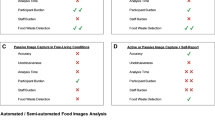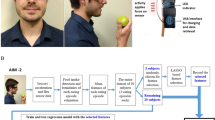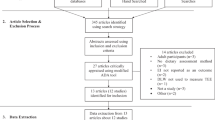Abstract
Background/Objectives:
Self-reported food records are commonly used to estimate dietary intake. However, diet diaries are time consuming for participants and children are often unfamiliar with standard portion sizes or weights/volume of foods that can add to the error associated with self-reported intake. We hypothesize that photographic food records to assess dietary intake will be as accurate as a standard food diary and will decrease participant/family burden.
Subjects/Methods:
A total of 28 healthy subjects, 10–16 years, consumed a weighed diet for 3 days and returned any uneaten items for weigh back on day 4. During the 3 days of weighed diet, subjects recorded all intake both using a standard diet diary and taking photographs before and after consumption. Photographs were analyzed by two independent dieticians for estimation of serving size. The actual amount consumed was compared to the diary and photographic estimates through Spearman's correlation coefficients and confidence intervals.
Results:
There was no difference between the diet diary and photographic estimates of total energy, carbohydrate, fat, protein, fiber, vitamins A, D and E, calcium, iron or zinc compared to actual intake. However, both participants and their parents reported that the photographic method was quicker, simpler and would be preferred if they were to record dietary intake in the future. In this study cohort, 36% of subjects accurately reported actual daily energy intake (±5% of actual intake), only 29% underreported energy intake and 35% overreported energy intake.
Conclusions:
Photographic food records can be used to accurately estimate dietary intake in a pediatric population. In addition, this method is less burdensome for the participants and their family.
This is a preview of subscription content, access via your institution
Access options
Subscribe to this journal
Receive 12 print issues and online access
$259.00 per year
only $21.58 per issue
Buy this article
- Purchase on Springer Link
- Instant access to full article PDF
Prices may be subject to local taxes which are calculated during checkout

Similar content being viewed by others
References
Aronoff S, Rosenblatt S, Braithwaite S, Egan JW, Mathisen AL, Schneider RL (2000). Pioglitazone hydrochloride monotherapy improves glycemic control in the treatment of patients with type 2 diabetes: a 6-month randomized placebo-controlled dose-response study. The Pioglitazone 001 Study Group. Diabetes Care 23, 1605–1611.
Bandini LG, Cyr H, Must A, Dietz WH (1997). Validity of reported energy intake in preadolescent girls. Am J Clin Nutr 65, 1138S–1141S.
Black AE, Cole TJ (2001). Biased over- or under-reporting is characteristic of individuals whether over time or by different assessment methods. J Am Diet Assoc 101, 70–80.
Blalock H (1972). Social Statistics. McGraw-Hill: New York.
Dror DK, Allen LH (2008). Effect of vitamin B12 deficiency on neurodevelopment in infants: current knowledge and possible mechanisms. Nutr Rev 66, 250–255.
Dwyer JT, Krall EA, Coleman KA (1987). The problem of memory in nutritional epidemiology research. J Am Diet Assoc 87, 1509–1512.
Goldbohm RA, van ‘t Veer P, van den Brandt PA, van ‘t Hof MA, Brants HA, Sturmans F et al. (1995). Reproducibility of a food frequency questionnaire and stability of dietary habits determined from five annually repeated measurements. Eur J Clin Nutr 49, 420–429.
Goris AH, Meijer EP, Kester A, Westerterp KR (2001). Use of a triaxial accelerometer to validate reported food intakes. Am J Clin Nutr 73, 549–553.
Haraldsdottir J, Hermansen B (1995). Repeated 24-h recalls with young schoolchildren. A feasible alternative to dietary history from parents? Eur J Clin Nutr 49, 729–739.
Kaczkowski CH, Jones PJ, Feng J, Bayley HS (2000). Four-day multimedia diet records underestimate energy needs in middle-aged and elderly women as determined by doubly-labeled water. J Nutr 130, 802–805.
Kroke A, Klipstein-Grobusch K, Voss S, Möseneder J, Thielecke F, Noack R et al. (1999). Validation of a self-administered food-frequency questionnaire administered in the European Prospective Investigation into Cancer and Nutrition (EPIC) Study: comparison of energy, protein, and macronutrient intakes estimated with the doubly labeled water, urinary nitrogen, and repeated 24-h dietary recall methods. Am J Clin Nutr 70, 439–447.
Lindquist CH, Cummings T, Goran MI (2000). Use of tape-recorded food records in assessing children's dietary intake. Obes Res 8, 2–11.
Livingstone MB, Robson PJ (2000). Measurement of dietary intake in children. Proc Nutr Soc 59, 279–293.
Livingstone MB, Robson PJ, Wallace JM (2004). Issues in dietary intake assessment of children and adolescents. Br J Nutr 92 (Suppl 2), S213–S222.
Mangione RA, Patel PN (2008). Caring for patients with celiac disease: the role of the pharmacist. J Am Pharm Assoc 48, e125–e135; quiz e136–e139.
Medlin C, Skinner JD (1988). Individual dietary intake methodology: a 50-year review of progress. J Am Diet Assoc 88, 1250–1257.
Rockett HR, Berkey CS, Colditz GA (2003). Evaluation of dietary assessment instruments in adolescents. Curr Opin Clin Nutr Metab Care 6, 557–562.
Rockett HR, Colditz GA (1997). Assessing diets of children and adolescents. Am J Clin Nutr 65, 1116S–1122S.
Romieu I, Trenga C (2001). Diet and obstructive lung diseases. Epidemiol Rev 23, 268–287.
Salas-Salvadó J, Fernández-Ballart J, Ros E, Martínez-González MA, Fitó M, Estruch R et al., PREDIMED Study Investigators (2008). Effect of a Mediterranean diet supplemented with nuts on metabolic syndrome status: one-year results of the PREDIMED Randomized Trial. Arch Intern Med 168, 2449–2458.
Scheen AJ (2008). The future of obesity: new drugs versus lifestyle interventions. Expert Opin Investig Drugs 17, 263–267.
Symonds ME (2009). Nutrition and its contribution to obesity and diabetes: a life-course approach to disease prevention? Proc Nutr Soc 68, 71–77.
Thompson FE, Byers T (1994). Dietary assessment resource manual. J Nutr 124, 2245S–2317S.
Virtanen JK, Mozaffarian D, Chiuve SE, Rimm EB (2008). Fish consumption and risk of major chronic disease in men. Am J Clin Nutr 88, 1618–1625.
Wang DH, Kogashiwa M, Ohta S, Kira S (2002). Validity and reliability of a dietary assessment method: the application of a digital camera with a mobile phone card attachment. J Nutr Sci Vitaminol (Tokyo) 48, 498–504.
Acknowledgements
This work was supported by NIH grant M01 RR00069. In addition, we thank Kodak, United States, for the donation of all disposable cameras utilized in this study. Janine Higgins conceived of the study design and was responsible for overall study coordination, conducting patient visits, data analysis and paper preparation. Audrey LaSalle was responsible for patient scheduling, day-to-day study coordination, conducting patient visits and data entry. Melanie Kasten conducted all data entry in NDS and assisted with paper preparation. Kristin Bing contributed to the study design and paper preparation. Pan Zhaoxing conducted all statistical analyses and assisted with paper preparation. Teresa Witten and Susan Ridzon conducted all dietician estimates of foods and serving sizes from study photographs.
Author information
Authors and Affiliations
Corresponding author
Additional information
Conflict of interest
All authors read and approved the final article and have no conflict of interest to disclose.
Appendices
Table A1
Table A2
Rights and permissions
About this article
Cite this article
Higgins, J., LaSalle, A., Zhaoxing, P. et al. Validation of photographic food records in children: are pictures really worth a thousand words?. Eur J Clin Nutr 63, 1025–1033 (2009). https://doi.org/10.1038/ejcn.2009.12
Received:
Revised:
Accepted:
Published:
Issue Date:
DOI: https://doi.org/10.1038/ejcn.2009.12
Keywords
This article is cited by
-
Statistical models for meal-level estimation of mass and energy intake using features derived from video observation and a chewing sensor
Scientific Reports (2019)
-
A feasibility study with process evaluation of a preschool intervention to improve child and family lifestyle behaviours
BMC Public Health (2017)
-
Novel Online or Mobile Methods to Assess Eating Patterns
Current Nutrition Reports (2017)
-
Feasibility of a SenseCam-assisted 24-h recall to reduce under-reporting of energy intake
European Journal of Clinical Nutrition (2013)
-
Validation of digital photographs, as a tool in 24-h recall, for the improvement of dietary assessment among rural populations in developing countries
Nutrition Journal (2012)



